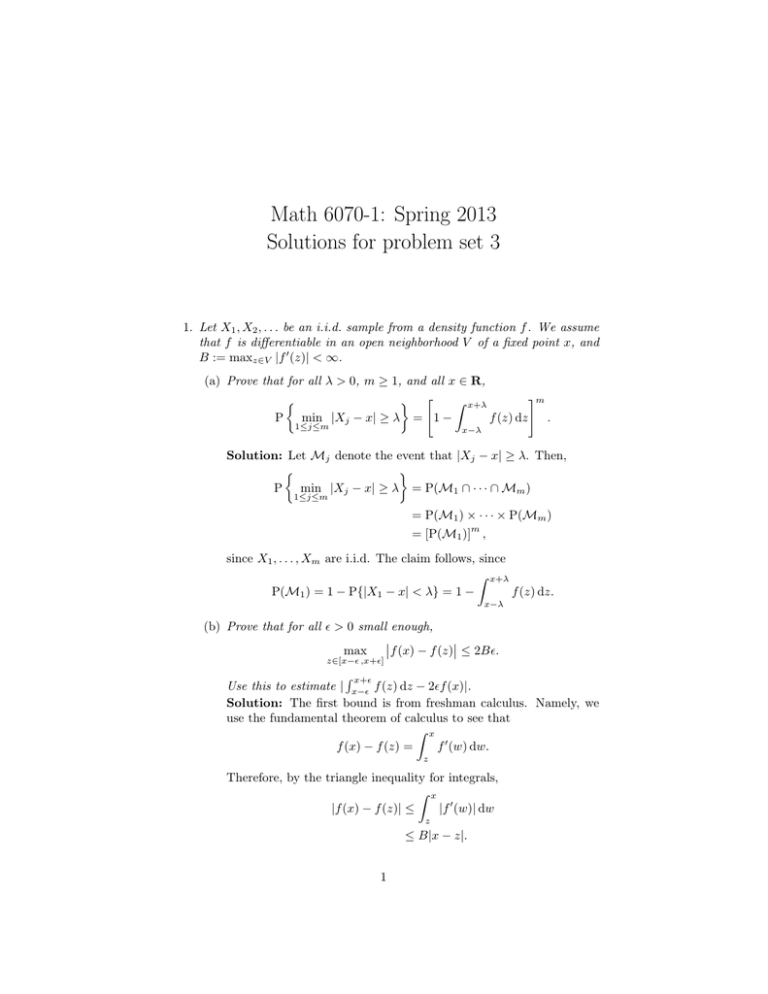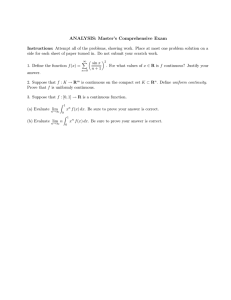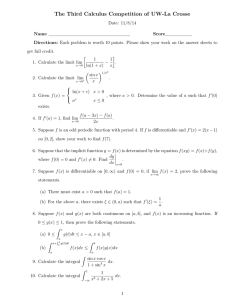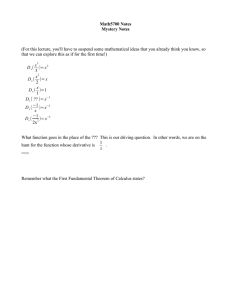Math 6070-1: Spring 2013 Solutions for problem set 3
advertisement

Math 6070-1: Spring 2013
Solutions for problem set 3
1. Let X1 , X2 , . . . be an i.i.d. sample from a density function f . We assume
that f is differentiable in an open neighborhood V of a fixed point x, and
B := maxz∈V |f 0 (z)| < ∞.
(a) Prove that for all λ > 0, m ≥ 1, and all x ∈ R,
#m
"
Z x+λ
P min |Xj − x| ≥ λ = 1 −
f (z) dz
.
1≤j≤m
x−λ
Solution: Let Mj denote the event that |Xj − x| ≥ λ. Then,
P min |Xj − x| ≥ λ = P(M1 ∩ · · · ∩ Mm )
1≤j≤m
= P(M1 ) × · · · × P(Mm )
m
= [P(M1 )] ,
since X1 , . . . , Xm are i.i.d. The claim follows, since
Z x+λ
P(M1 ) = 1 − P{|X1 − x| < λ} = 1 −
f (z) dz.
x−λ
(b) Prove that for all > 0 small enough,
f (x) − f (z) ≤ 2B.
max
z∈[x− ,x+]
R x+
Use this to estimate | x− f (z) dz − 2f (x)|.
Solution: The first bound is from freshman calculus. Namely, we
use the fundamental theorem of calculus to see that
Z x
f (x) − f (z) =
f 0 (w) dw.
z
Therefore, by the triangle inequality for integrals,
Z x
|f (x) − f (z)| ≤
|f 0 (w)| dw
z
≤ B|x − z|.
1
This yields the bound
max
z∈[x− ,x+]
f (x) − f (z) ≤ B,
which is slightly better than the one we are asked to derive.
Next we use a trick that we used in the context of density estimation
[for convolutions]. Namely, we write
Z x+
Z x+
f (z) dz − 2f (x) =
[f (z) − f (x)] dz.
x−
x−
Then, apply the triangle inequality for integrals in order to obtain
Z x+
Z x+
=
[f
(z)
−
f
(x)]
dz
f
(z)
dz
−
2f
(x)
x−
x−
Z x+
≤
|f (z) − f (x)| dz
x−
≤ 2B2 .
(c) Suppose that as m → ∞, λm → ∞ and λ2m /m → 0. Then, prove
that
−1
λm
lim
= f (x).
ln P min |Xj − x| ≥
m→∞ 2λm
1≤j≤m
m
Solution: Throughout, let us write
Z x+(λm /m)
δm :=
f (z) dz.
x−(λm /m)
We know that limm→∞ δm = 0, thanks to freshman calculus. In fact,
δm =
2Bλ2m
2λm
f (x) ±
,
m
m2
thanks to part (b).
Part (a) shows that
−1
λm
−m
ln P min |Xj − x| ≥
=
ln(1 − δm ).
1≤j≤m
2λm
m
2λm
According to Taylor’s expansion, from freshman calculus,
2
δm
− ···
2
2
2λm
2Bλ2m
1 2λm
2Bλ2m
=−
f (x) ∓
+
f (x) ±
m
m2
2
m
m2
2 2
2λm
(2B + [2f (x)] )λm
=−
f (x) ∓
+ ··· .
m
m2
ln(1 − δm ) = −δm +
2
The point is that the error of approximation is bounded above by
some finite constant times λ2m /m2 . In particular,
lim
m→∞
−m
ln(1 − δm ) = f (x),
2λm
which is another way to rewrite the statement.
(d) Devise an estimator of f (x) based on the previous steps.
Solution: Suppose X1 , . . . , Xn is i.i.d. data from pdf f , and suppose
that we can choose and fix an integer 1 m n such that n divides
m. Block your data into (n/m) − 1 sub-blocks of length m; that is,
, . . . , X2m , . . . , Xn−m+1 , . . . , Xn
X ,...,X ,X
| 1 {z m} | m+1 {z
}
|
{z
}
first block
second block
last block
These blocks are i.i.d. Moreover, we know from part (c) that
λm
P Every term in the jth block is at least
away from x ≈ e−λm f (x) ,
m
provided only that m is large. By the law of large numbers, since
n m, and since there are (n/m) − 1 ≈ (n/m) blocks,
m
n
(n/m)−1
X
j=1
λm
I Every term in the jth block is at least
away from x ≈ e−λm f (x) .
m
Therefore, a reasonable estimator is
(n/m)−1 X
λm
−1 m
I Every term in the jth block is at least
away from x .
fb(x) :=
ln
λm
n j=1
m
If you cannot find such an (n , m) pair exactly, then divide the data
into m blocks that are equally-sized, inasmuch as possible. Any such
division works just as well as any other, and works as in the preceding.
3





